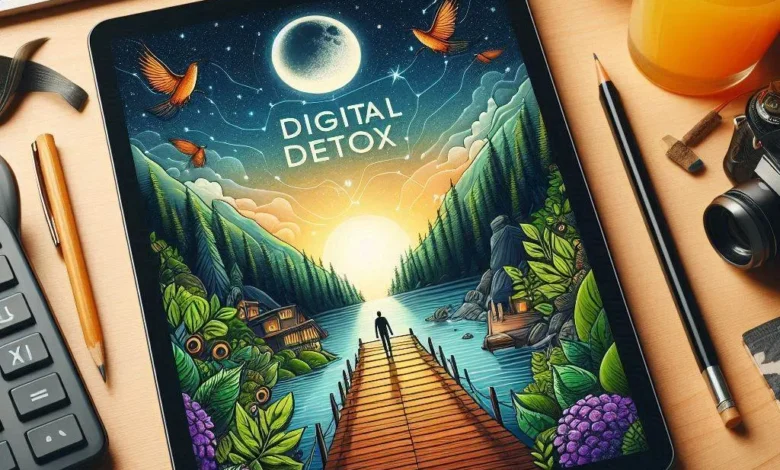Digital Detox: The Path to Rediscovering Work-Life Balance

Introduction: The Digital Detox Revolution
In today’s hyper-connected world, the concept of a digital detox is gaining traction. But what exactly is it? A digital detox means taking a break from electronic devices and digital media. It’s a chance to step back from the constant buzz of notifications and endless scrolling.
Why is this important? Our lives are increasingly intertwined with technology, often blurring the lines between work and personal time. This can lead to an unhealthy imbalance, affecting our well-being and relationships.
A digital detox offers numerous benefits:
- Improved focus and productivity
- Better sleep quality
- Reduced stress and anxiety
- Enhanced face-to-face relationships
- Increased mindfulness and present-moment awareness
The Impact of Digital Overload on Work-Life Balance
The constant connectivity enabled by technology has dramatically altered our work-life balance. Let’s explore how:
Productivity Paradox:
- Always-on culture leads to frequent interruptions
- Multitasking decreases efficiency and quality of work
- Difficulty in focusing on single tasks for extended periods
Relationship Strain:
- Less quality time with family and friends
- Decreased intimacy and meaningful conversations
- “Phubbing” (snubbing others in favor of your phone) becoming common
Health Consequences:
- Physical issues:
• Eye strain and headaches
• Poor posture and back problems
• Disrupted sleep patterns - Mental health concerns:
• Increased stress and anxiety
• FOMO (Fear of Missing Out)
• Symptoms of depression
The impact of digital overload extends far beyond just feeling busy. It affects our core well-being and ability to maintain healthy relationships. Recognizing these effects is the first step towards reclaiming balance in our lives.
Signs You Need a Digital Detox
Are you wondering if it’s time for a digital detox? Here are some common signs that indicate you might benefit from unplugging:
- Constant Checking: You feel an urge to check your phone or email every few minutes.
- Sleep Disruption: The last thing you see at night and the first thing you check in the morning is your device.
- Neglected Hobbies: You’ve abandoned offline activities you once enjoyed.
- Difficulty Focusing: You struggle to concentrate on tasks without digital distractions.
- Physical Discomfort: You experience headaches, eye strain, or neck pain from excessive screen time.
- Social Media Comparison: You often feel inadequate after scrolling through social media.
- Phantom Vibrations: You think your phone is buzzing even when it’s not.
Self-Assessment Checklist
Take a moment to reflect on your digital habits. Answer these questions honestly:
- Do you feel anxious when you’re without your phone?
- Has your screen time increased significantly in recent months?
- Do you often lose track of time when using digital devices?
- Have friends or family commented on your device use?
- Do you find it hard to be present in social situations without checking your phone?
If you answered “yes” to two or more of these questions, you might benefit from a digital detox.
Benefits of a Digital Detox
Embarking on a digital detox can lead to remarkable improvements in various aspects of your life. Let’s compare the “before” and “after” scenarios:
| Aspect | Before Digital Detox | After Digital Detox |
|---|---|---|
| Focus | Easily distracted, multitasking | Improved concentration, better single-tasking |
| Productivity | Frequent interruptions, longer task completion time | Increased efficiency, more tasks completed |
| Relationships | Surface-level interactions, phubbing | Deeper connections, more meaningful conversations |
| Mental Health | Heightened stress and anxiety | Reduced stress, improved mood |
| Creativity | Mental clutter, recycled ideas | Fresh perspectives, increased innovation |
| Sleep | Disrupted sleep patterns | Better sleep quality, more restful nights |
| Physical Health | Sedentary lifestyle, eye strain | More physical activity, reduced digital-related ailments |
How to Plan Your Digital Detox
Planning is crucial for a successful digital detox. Follow these steps to create your personalized plan:
- Set Realistic Goals: Start small. Maybe begin with a 24-hour detox and gradually increase the duration.
- Choose Your Detox Type: Decide if you want a complete disconnect or just limit certain apps or devices.
- Identify Essential vs. Non-essential: Determine which digital activities are truly necessary and which can be paused.
- Create a Support System: Inform friends, family, and colleagues about your detox. Ask for their understanding and support.
- Plan Offline Activities: Prepare a list of enjoyable offline activities to fill your time.
- Set Clear Boundaries: Establish rules for emergencies or essential communications.
- Prepare for Challenges: Anticipate potential difficulties and plan how to overcome them.
Remember, the goal is progress, not perfection. Be kind to yourself as you embark on this journey to reclaim your work-life balance.
Practical Digital Detox Strategies
Implementing a digital detox doesn’t have to be daunting. Here are some practical strategies you can incorporate into your daily life:
Screen-Free Mornings and Evenings
- Start your day with a tech-free routine (e.g., meditation, exercise, reading)
- Set a “digital curfew” at least an hour before bedtime
- Use a traditional alarm clock instead of your phone
Designated Tech-Free Zones at Home
- Create device-free areas (e.g., dining room, bedroom)
- Use these spaces for face-to-face interactions and relaxation
- Encourage family members to respect these zones
Digital-Free Weekends or Vacations
- Plan regular tech-free days or weekends
- Consider a “digital-free” vacation to fully disconnect
- Rediscover hobbies and outdoor activities during this time
Mindful Use of Social Media and Email
- Set specific times for checking and responding to messages
- Use app blockers or time-limiting features
- Unfollow accounts that don’t add value to your life
Overcoming Challenges During Your Digital Detox
Embarking on a digital detox can present some hurdles. Here’s how to address common concerns:
Q: What if I miss important work emails?
A: Communicate your detox plans to colleagues. Set up an auto-responder for emergencies.
Q: How do I deal with FOMO (Fear of Missing Out)?
A: Remember, true meaningful experiences happen offline. Focus on creating memories, not documenting them.
Q: I use my phone for everything. How can I function without it?
A: Rediscover analog tools: use a physical calendar, write notes by hand, use a map for navigation.
Q: What if I get bored?
A: Boredom can spark creativity. Use this time to explore new hobbies or rekindle old interests.
Maintaining a Healthy Digital Balance Post-Detox
After your detox, it’s crucial to maintain a healthy relationship with technology. Here’s a weekly planner template to help you achieve balance:
| Day | Digital-Free Time | Mindful Tech Use | Offline Activities |
|---|---|---|---|
| Monday | 6 AM – 9 AM | Check emails at set times | Morning workout |
| Tuesday | 8 PM – bedtime | No social media after 6 PM | Evening family game night |
| Wednesday | Lunch hour | Respond to messages in batches | Midday walk |
| Thursday | 7 PM – bedtime | No work emails after 7 PM | Read a book before bed |
| Friday | 6 AM – 9 AM | Tech-free work breaks | Morning meditation |
| Saturday | Full day | Emergency check-ins only | Outdoor activities |
| Sunday | Until 12 PM | Limit screen time to 2 hours | Brunch with friends |
The Role of Technology in a Balanced Life
While we’ve focused on reducing tech use, it’s important to acknowledge the positive aspects of technology:
- Facilitates global communication and connection
- Provides access to vast amounts of information and learning resources
- Enables remote work and flexible schedules
- Offers tools for health monitoring and self-improvement
The key is to practice “tech hygiene” – using technology intentionally and mindfully. This means:
- Choosing apps and tools that genuinely improve your life
- Setting clear boundaries for tech use
- Regularly assessing and adjusting your digital habits
- Using technology to enhance, not replace, real-world experiences
By maintaining this balanced approach, you can harness the benefits of technology while avoiding its pitfalls.
Conclusion: Embracing the Digital Detox Journey
In our increasingly connected world, the concept of a digital detox has become more than just a trendy phrase—it’s a necessary step towards reclaiming our work-life balance. Let’s recap the key points we’ve explored:
- The need for digital detox: We’ve seen how constant connectivity can lead to decreased productivity, strained relationships, and various health issues.
- Signs of digital overload: From constant checking to neglected hobbies, recognizing these signs is crucial in understanding when it’s time to unplug.
- Benefits of unplugging: A digital detox can lead to improved focus, better relationships, enhanced creativity, and overall well-being.
- Practical strategies: We’ve discussed various approaches, from tech-free zones to mindful social media use, that can help you integrate digital detox into your daily life.
- Overcoming challenges: By addressing common concerns and planning ahead, you can navigate the difficulties of disconnecting.
- Maintaining balance: Post-detox, it’s important to establish new habits that promote a healthy relationship with technology.
Remember, the goal isn’t to completely eliminate technology from your life. Instead, it’s about creating a mindful, intentional relationship with digital tools. By doing so, you can harness the benefits of technology while avoiding its potential pitfalls.
Your Next Steps
As you conclude reading this article, consider taking these actions:
- Assess your current digital habits: Use the self-assessment checklist provided earlier to evaluate your relationship with technology.
- Start small: Choose one digital detox strategy to implement this week. It could be as simple as a tech-free dinner or a screen-free hour before bed.
- Plan a more extended detox: Based on your comfort level, schedule a longer period of digital disconnection, perhaps a full day or a weekend.
- Engage your support system: Share your digital detox goals with friends and family. Invite them to join you in the challenge.
- Reflect and adjust: After your detox experience, take time to reflect on the changes you noticed. Use these insights to create a sustainable plan for balanced tech use.
Final Thoughts
In our quest for connectivity, we often lose touch with the most important connections—those with ourselves, our loved ones, and the world around us. A digital detox offers a path to rediscovering these essential connections and achieving true work-life balance.
Remember, it’s not about perfection, but progress. Each step you take towards mindful tech use is a step towards a more balanced, fulfilling life. So, are you ready to unplug and reconnect with what truly matters?
Your journey to a healthier relationship with technology starts now. Embrace the digital detox revolution and rediscover the joy of living in the moment, undistracted by the constant buzz of the digital world.



